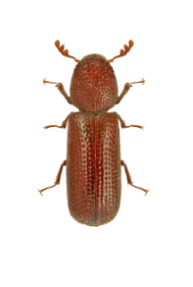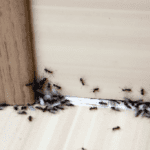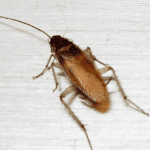Warehouse beetles
Warehouse beetles
Coleoptera (commonly beetles) are together with Lepidoptera (butterflies) the most common groups of insects found in stored products.
A warehouse insect is defined as an insect that can cause damage to stored products, and can also grow and reproduce in areas that house such products.
The agricultural products affected are mainly grain seeds (wheat, barley, corn, rice, oats, etc.), flour, legume seeds (beans) as well as other foods such as dried fruits and vegetables. Also another product degraded by insects during storage is tobacco.
Depending on their ability to attack the seeds they are classified into two categories:
- Primary species (primary pest): Insects capable of infesting intact seeds (i.e. unbroken seeds)
- Secondary species (secondary pest): Insects that infest a product already infested or mechanically broken (eg flour).
Most Important Items:
- Sitophilus spp

-
S. oryzae(common: rice beetle)
S. granarius (common: wheat beetle)Mainly affects whole grains of cereals (wheat, rice, oats, barley, sorghum, rye, maize)

- Rhyzopertha dominica
It is considered one of the most common insects - enemies in stored rice and wheat in Greece.
It also attacks other grains such as barley, corn, but also biscuits and other flour products.

- Οικογένεια Bruchidae
It is commonly called Bean Loop. It affects a wide range of whole legumes, but mainly beans and soybeans.

- Trogoderma granarium
The seed weevil is considered a "quarantine" enemy. for many countries. It is very destructive to stored grain and other vegetable matter.
Damage is also caused by:
- Lasioderma serricorne (commonly known as the dry tobacco beetle): Infests dried tobacco as well as a wide range of seeds and spices.
- Tribolium confusum (commonly beetle or mealybug): Serious enemy of all types of seeds and in flour
- Oryzaephilus surinamensis (common toothed beetle): It affects a wide range of seeds, dried plants and salty foodstuffs.
- Carpophilus hemipterus (commonly dry fruit beetle):Prefers overripe fruits in storage such as figs, dates, raisins, etc.

Integrated Treatment
Step 1 – PREVENTION
- Good sanitary conditions
- Durable packing material
- Short storage time of the products
- Equipment of the warehouse: waterproofing, smooth and rounded corners on the floors, proper placement of the products to be disinfected.
STEP 2 – MONITORING
Monitoring relies on the use of traps to identify and estimate the population of warehouse beetles. The most common types of traps are light traps and type D traps that contain pheromone.
General autumn cleaning is more important for your health than you think
STEP 3 – CHEMICAL PROCESSING
- By using fumigation (phosphine)
- By using approved insecticides. They are applied either by spraying on the surfaces of the warehouse, or on the packaging materials (e.g. sacks) or on the stored seeds.
Read hundreds of articles that will answer any question about #cleansecta by clicking here.




